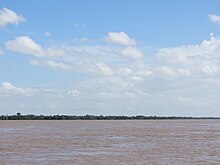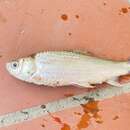Diagnostic Description
provided by Fishbase
This species is distinguished from its congeners by the following set of characters: mouth terminal, strongly oblique (35â45° to midline of body); no maxillary barbels; edge of rostral cap is straight, no medial indent; flank immaculate, no longitudinal stripes; caudal peduncle immaculate, no spot; caudal fin mostly clear, with scattered melanophores; in life, pectoral, pelvic, and anal fins hyaline (Ref. 123185).
- Recorder
- Estelita Emily Capuli
Migration
provided by Fishbase
Potamodromous. Migrating within streams, migratory in rivers, e.g. Saliminus, Moxostoma, Labeo. Migrations should be cyclical and predictable and cover more than 100 km.
- Recorder
- Christine Marie V. Casal
Biology
provided by Fishbase
Often found in great abundance at midwater to bottoms depths in large and small rivers. Feeds on algae, periphyton and phytoplankton. Not known to prosper in impoundments. Well known for its annual trophic migrations out to the floodplains in wet season. Returns to rivers as water levels begin to fall in October with numbers increasing through December and then slowly declining (Ref. 12693). From just upstream Phnom Penh in Cambodia to the Khone Falls this species is reported to migrate upstream during the period October-February. At Muk Kompul in Kandal Province, it migrates upstream just before the full moon. Further upstream near Kratie, migration occurs during full moon and at Sambor, migration takes place immediately after full moon. Near the Khone Falls, upstream movements continue through March but in April fish are moving in both direction. From May to July, at the start of the rainy season, it migrates downstream from the Khone Falls to the Mekong Delta. Here, the fish is reported to move out of the Mekong into canals and flooded areas in August-September. When water recedes in November-December, fish migrates to the Mekong again. Upstream the Khone Falls near Ubolratchatani in Thailand, this species moves upstream between February and June, consisting mainly of juveniles in February-March and of adults (15-20 cm) in April-June. Further upstream from Xayabouri in Laos to Chiang Khong in Thailand, upstream migrations takes place between March to July, first by juveniles, later by adults (Ref. 37770). Used to make prahoc along the Tonlé Sap, Cambodia. Often seen in the aquarium trade (Ref. 12693).
- Recorder
- Christine Marie V. Casal
Importance
provided by Fishbase
fisheries: commercial; aquarium: commercial
- Recorder
- Christine Marie V. Casal
Siamese mud carp: Brief Summary
provided by wikipedia EN
The Siamese mud carp (Henicorhynchus siamensis) is a species of freshwater cyprinid fish, a variety of Asian carp native to the Mekong and Chao Phraya Rivers in Southeast Asia, especially in Cambodia, Laos and Thailand. It is very common in floodplains during the wet season and migrates upstream in the Mekong starting in Cambodia.

Map showing the course of the Mekong River.
The Siamese mud carp has commercial use locally, both as food and in the aquarium trade.

Mekong River, prime habitat of the Siamese mud carp.
Local names:
Thai: pla soi khao (ปลาสร้อยขาว, pronounced
[plāː sɔ̂j kʰǎːw])
Laotian: ປາຊວຍ
[paː swáːj] Khmer: trey riel tob (ត្រីរៀលតុបគា)
Vietnamese: Cá linh thùy.
- license
- cc-by-sa-3.0
- copyright
- Wikipedia authors and editors


 Map showing the course of the Mekong River.
Map showing the course of the Mekong River.  Mekong River, prime habitat of the Siamese mud carp.
Mekong River, prime habitat of the Siamese mud carp.